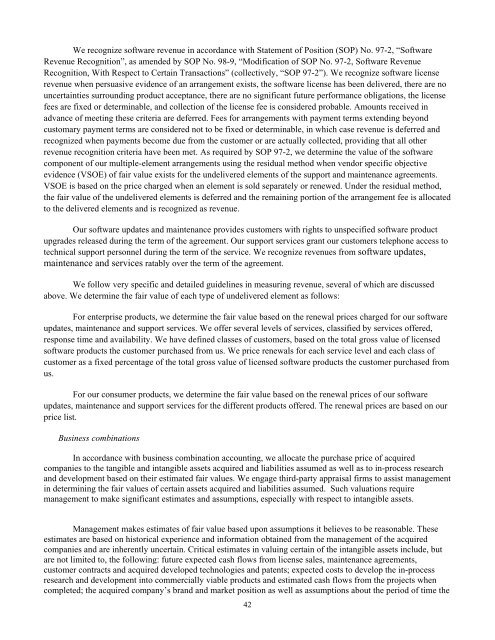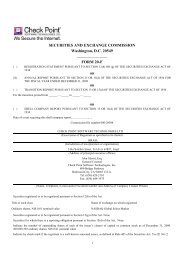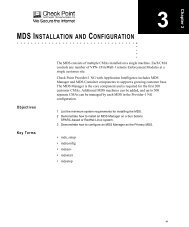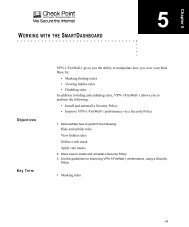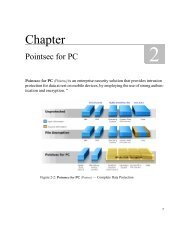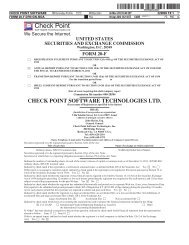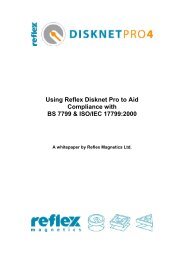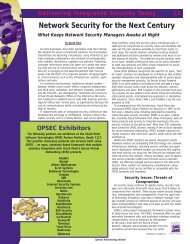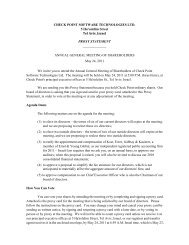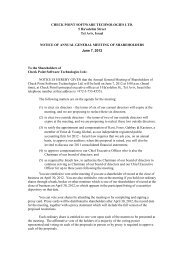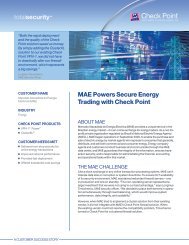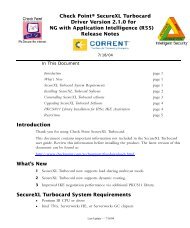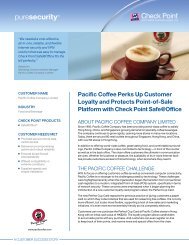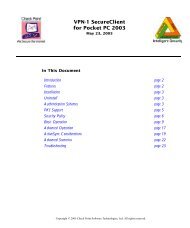FORM 20-F - Check Point
FORM 20-F - Check Point
FORM 20-F - Check Point
Create successful ePaper yourself
Turn your PDF publications into a flip-book with our unique Google optimized e-Paper software.
We recognize software revenue in accordance with Statement of Position (SOP) No. 97-2, “Software<br />
Revenue Recognition”, as amended by SOP No. 98-9, “Modification of SOP No. 97-2, Software Revenue<br />
Recognition, With Respect to Certain Transactions” (collectively, “SOP 97-2”). We recognize software license<br />
revenue when persuasive evidence of an arrangement exists, the software license has been delivered, there are no<br />
uncertainties surrounding product acceptance, there are no significant future performance obligations, the license<br />
fees are fixed or determinable, and collection of the license fee is considered probable. Amounts received in<br />
advance of meeting these criteria are deferred. Fees for arrangements with payment terms extending beyond<br />
customary payment terms are considered not to be fixed or determinable, in which case revenue is deferred and<br />
recognized when payments become due from the customer or are actually collected, providing that all other<br />
revenue recognition criteria have been met. As required by SOP 97-2, we determine the value of the software<br />
component of our multiple-element arrangements using the residual method when vendor specific objective<br />
evidence (VSOE) of fair value exists for the undelivered elements of the support and maintenance agreements.<br />
VSOE is based on the price charged when an element is sold separately or renewed. Under the residual method,<br />
the fair value of the undelivered elements is deferred and the remaining portion of the arrangement fee is allocated<br />
to the delivered elements and is recognized as revenue.<br />
Our software updates and maintenance provides customers with rights to unspecified software product<br />
upgrades released during the term of the agreement. Our support services grant our customers telephone access to<br />
technical support personnel during the term of the service. We recognize revenues from software updates,<br />
maintenance and services ratably over the term of the agreement.<br />
We follow very specific and detailed guidelines in measuring revenue, several of which are discussed<br />
above. We determine the fair value of each type of undelivered element as follows:<br />
For enterprise products, we determine the fair value based on the renewal prices charged for our software<br />
updates, maintenance and support services. We offer several levels of services, classified by services offered,<br />
response time and availability. We have defined classes of customers, based on the total gross value of licensed<br />
software products the customer purchased from us. We price renewals for each service level and each class of<br />
customer as a fixed percentage of the total gross value of licensed software products the customer purchased from<br />
us.<br />
For our consumer products, we determine the fair value based on the renewal prices of our software<br />
updates, maintenance and support services for the different products offered. The renewal prices are based on our<br />
price list.<br />
Business combinations<br />
In accordance with business combination accounting, we allocate the purchase price of acquired<br />
companies to the tangible and intangible assets acquired and liabilities assumed as well as to in-process research<br />
and development based on their estimated fair values. We engage third-party appraisal firms to assist management<br />
in determining the fair values of certain assets acquired and liabilities assumed. Such valuations require<br />
management to make significant estimates and assumptions, especially with respect to intangible assets.<br />
Management makes estimates of fair value based upon assumptions it believes to be reasonable. These<br />
estimates are based on historical experience and information obtained from the management of the acquired<br />
companies and are inherently uncertain. Critical estimates in valuing certain of the intangible assets include, but<br />
are not limited to, the following: future expected cash flows from license sales, maintenance agreements,<br />
customer contracts and acquired developed technologies and patents; expected costs to develop the in-process<br />
research and development into commercially viable products and estimated cash flows from the projects when<br />
completed; the acquired company’s brand and market position as well as assumptions about the period of time the<br />
42


